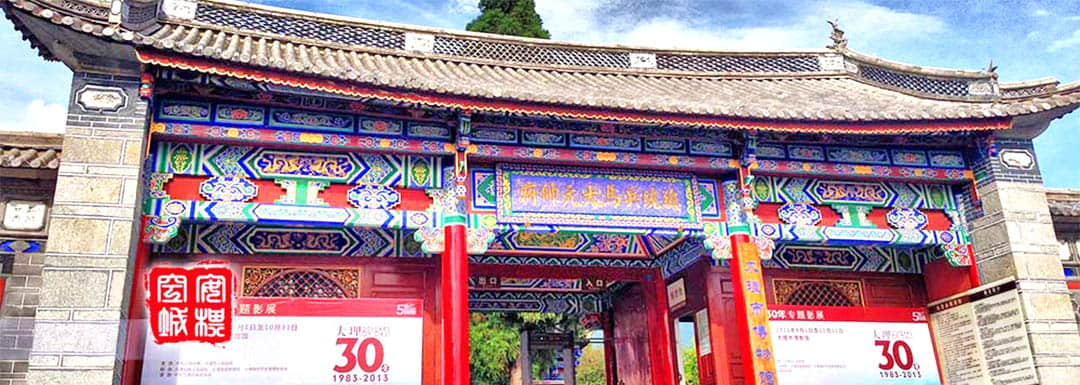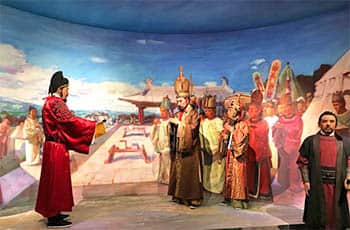The Dali Bai Nationality Autonomous Perfecture Museum

The museum is the first prefecture-level museum built in Yunnan Province. The museum covers an area of 50 mu (3.3 hectares), with a total construction area of 8,800 square meters, a green area of 14,000 square meters, and an exhibition area of 4,600 square meters. Dali Bai Nationality Autonomous Prefecture Museum has delightful surroundings. Its exhibition hall clearly shows the domestic house architectural style of Bai: 'Three rooms and one wall screening, four joints and five courtyards'.
- Chinese name: 大理州博物馆 Dà lǐ zhōu bó wù guǎn
- Constructed: 1986
- Suggested time: 1-3 hours
- Ticket: free
- Address: 8 Erhe South Road, Xiaguan Town, Dali City
- Open hours: 9.00-16.00 closed on Monday
- Best time to visit: all year round
- How to get there: take the No. 6 bus from Xiaguan
Highlights of the museum
This museum focuses on the historical relics of the Nanzhao Kingdom and Dali Kingdom. The art of bronze, ceramic and stone carvings are the mainstay. It highlights the folk characteristics of the Bai people. There are 12 exhibition halls in the pavilion and 8 long-term exhibition halls.
The Nanzhao Kingdom History Exhibition
The exhibition displays the history and culture of Dali Paleolithic, Neolithic, and Bronze ages, the Han and Jin Dynasties, Nanzhao Dali Kingdom, the Yuan, Ming and Qing Dynasties and modern times. The focus is on bronzeware culture, farming culture, and the history and culture of Nanzhao and Dali.
Dali Bronzeware Culture Exhibition
The exhibition hall used these bronze wares, which were produced more than 1,000 years ago, as symbols to show people that Yunnan entered the civilized era. During the Warring States Period, the bronze casting and production techniques in the Erhai area were extremely exquisite and reached a high level of art. More than 2,000 kinds of bronzes were excavated in Hongtupo, Xiangyun County, which fully demonstrated the peak period of bronze culture in the Erhai area.
 Dali Historical Figures Exhibition
Dali Historical Figures Exhibition Dali Historical Figures Exhibition
The exhibition hall displays important politicians of all ages in the history of Dali. There are revolutionary heroes in the history of modern Chinese revolution, and there are many great figures. In the splendid history and culture of Dali, they have made indelible contributions, and at the same time they have made great contributions to the rise and growth of the entire Chinese nation.
Dali Painting and Calligraphy Art Exhibition
The exhibition shows representative Dali book painters, famous Yunnan and national famous artists such as Li Yuanyang, Dan Dang, Yang Shengqi, Zhong Feng, Shi Xueyun, Bai Ding, Zhang Yi, Yang Yingxuan, Wang Wei, Zhang Shilian, and Zhang Wenlin. More than 80 paintings and calligraphy works by Yuan Jiagu, Zhao Wei, He Shaoji and others are also exhibited here.
Dali Pottery Art Exhibition
Dali was one of the earliest and richest areas of ancient Yunnan pottery find sites. Potteries were discovered from the Neolithic Age to the Yuan, Ming and Qing Dynasties. The fine porcelain displayed in this exhibition hall is mainly composed of green glazed porcelain and blue-and-white porcelain. It is of great significance for studying the ancient porcelain industry and related social conditions in Dali.
 Bai Culture Exhibition
Bai Culture Exhibition Bai Culture Exhibition
The exhibition mainly introduces the Neolithic Age, as early as 4,000 years ago, and more than 3,000 years ago, when the Bai culture emerged as a splendid bronze culture and rice farming civilization twice. It also presents the formation of the Bai community in the Tang and Song Dynasties. Bai people created the culture of the Nanzhao Dali Kingdom, which was once the mainstream culture of Yunnan for more than 500 years. They also promoted the historical development of Yunnan.
Bai Primitive Religion Culture Exhibition
The exhibition mainly introduces the worship of ‘the Lord’ as a unique religious belief of the Bai people. The meaning of ‘the Lord’ is that it is ‘the Lord’ who is in charge of this certain area. ‘The Lord’ protects the people who live in this area. The worship of ‘the Lord’ has lasted for more than 1,000 years. Among the main gods, there are natural cults, there are gods in Buddhism and Taoism, there are people in history and legends who have merits and deeds, and there are ordinary people.
Nanzhao Kingdom Buddhist Stone Carvings Exhibition
 Nanzhao Kingdom Buddhist Stone Carvings Exhibition
Nanzhao Kingdom Buddhist Stone Carvings Exhibition Most of the stone carvings in the Nanzhao Dali period were dominated by the Tantric goddess Guanyin, Bodhisattva, and the Great Black God. At the same time, the statues of the Nanzhao emperor, such as the Luo Feng, were also carved in the grottoes to show the rich local characteristics and the national style. They are with typical Ayili religion characteristics. These stone carvings are precious material to study the history, politics, culture and art of Nanzhao Dali.
Nanzhao Kingdom Buddhist Art Exhibiton
The Buddhist statues have various types of textures, and the designs are extremely exquisite. Most of them are known as the ‘Yunnan Fuxing’. The Ayurvedic image of Buddhism is the masterpiece of Buddhism in this period. ‘Zhang Shengwen's Picture’ and ‘Nanzhao Tuzhuan’ are the classical representations of the Buddhist painting art in Nanzhao Dali.
Marble Culture Exhibition
According to archaeological findings, the large-scale mining and production of marble began in the Tang Dynasty. Marble is mainly composed of calcium carbonate, containing trace amounts of silica, magnesium, iron and other metals, and non-metallic metamorphic limestone. It’s famous for its beautiful colors and natural patterns. Because marble has a unique decorative ornamental value, it has been appreciated and loved by people for a long time.
Drop us a line and we'll connect you with the top China expert in no time!